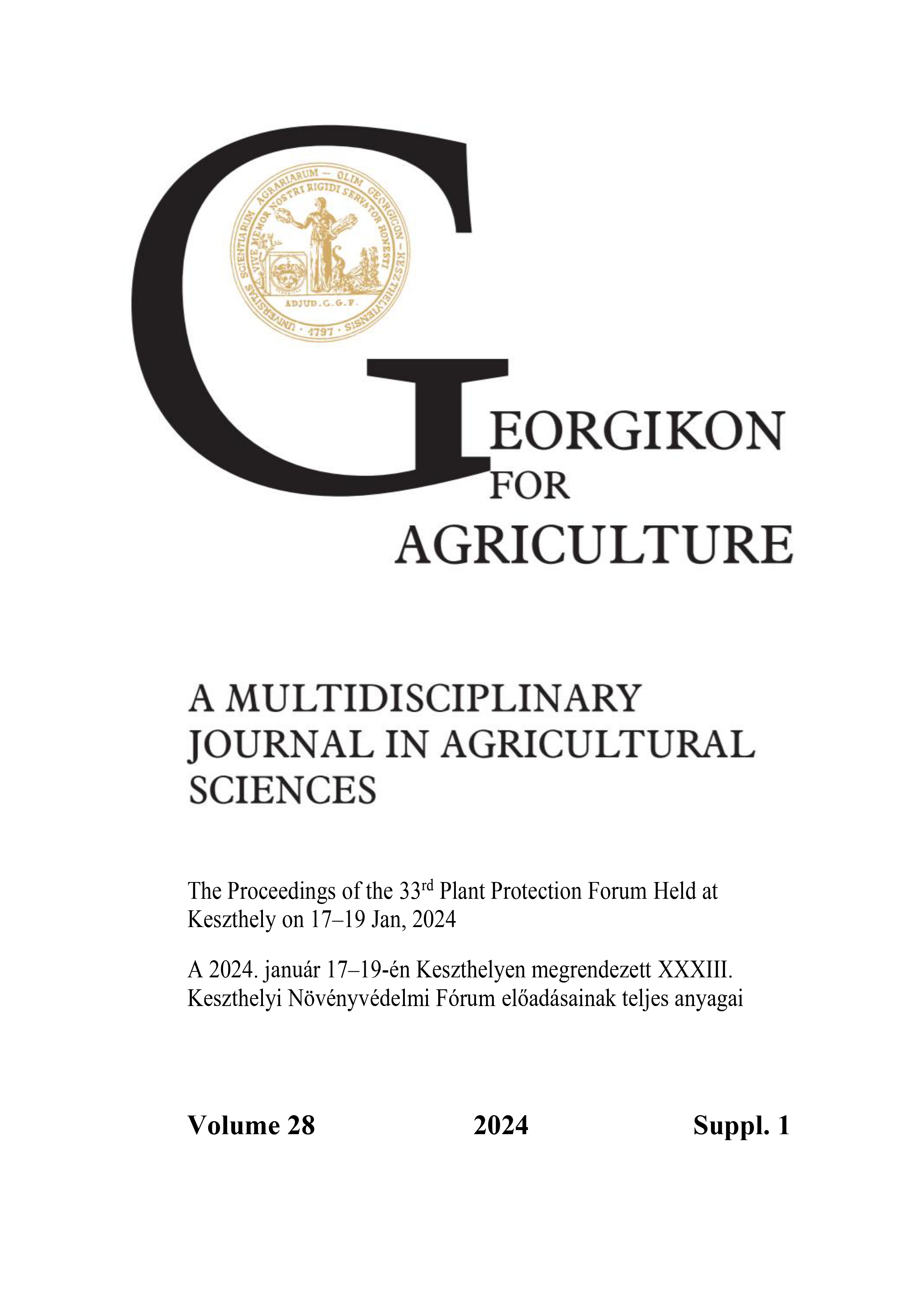Naturally Occurring Aspergillus Species and their Mycotoxigenic Potential from Hungarian Sorghum (Sorghum Bicolor L. Moench) Kernels
Keywords:
aflatoxin, sorghum, aflatoxigenic genes, molecular identification, toxigenic fungiAbstract
This study examined and identified the occurring Aspergillus spp. from sorghum (Sorghum bicolor L. Moench) kernels. We examined the internal infections of sorghum grains in PPA medium. During our experiments, we also used molecular methods to identify Aspergillus species and their genes, which promote aflatoxin production. This study identified two different Aspergillus species: A. flavus and A. oryzae. During identifying the genes, we detected that some of our A. flavus species could be aflatoxin-producing isolates.
References
Bakari, H., Djomdi, Ruben, Z. F., Roger, D. D., Cedric, D., Guillaume, P., Pascal, D., Philippe, M. and Gwendoline, C. 2023. Sorghum (Sorghum bicolor L. Moench) and its main parts (by-products) as promising sustainable sources of value-added ingredients. Waste and Biomass Valorization. 14 1023–1044. https://doi.org/10.1007/s12649-022-01992-7
Baranyi, N., Despot, D. J., Palágyi, A., Kiss, N., Kocsubé, S., Szekeres, A. and Varga, J. 2015. Identification of Aspergillus species in Central Europe able to produce G-type aflatoxins. Acta Biologica Hungarica. 66 339–347. https://doi.org/10.1556/018.66.2015.3.9
Chang, P. K., and Ehrlich, K. C. 2010. What does genetic diversity of Aspergillus flavus tell us about Aspergillus oryzae? International journal of food microbiology. 138 (3) 189–199. https://doi.org/10.1016/j.ijfoodmicro.2010.01.033
Chikara, N., Abdulahi, B., Munezero, C., Kaur, R., Singh, G. and Panghal, A. 2019. Exploring the nutritional and phytochemical potential of sorghum in food processing for food security, Nutrition & Food Science. 49 (2) 318–332. https://doi.org/10.1108/NFS-05-2018-0149
Degola, F., Berni, E., Dall’Asta, C., Spotti, E., Marchelli, R., Ferrero, I. and Restivo, F.M. 2007. A multiplex RT-PCR approach to detect aflatoxigenic strains of Aspergillus flavus. Journal of Applied Microbiology. 103 (2) 409–417. https://doi.org/10.1111/j.1365-2672.2006.03256.x
Dobolyi, C. S., Sebők, F., Varga, J., Kocsubé, S., Szigeti, G., Baranyi, N. and Kukolya, J. 2013. Occurrence of aflatoxin producing Aspergillus flavus isolates in maize kernel in Hungary. Acta Alimentaria. 42 (3) 451–459. https://doi.org/10.1556/aalim.42.2013.3.18
Frisvad, J., Hubka, V., Ezekiel, C., Hong, S.-B., Nováková, A., Chen, A., Arzanlou, M., Larsen, T., Sklenář, F., and Mahakarnchanakul, W. 2018. Taxonomy of Aspergillus section Flavi and their production of aflatoxins, ochratoxins and other mycotoxins. Stud. Mycol. 93 1–63. https://doi.org/10.1016/j.simyco.2018.06.001
Gallo, A., Stea, G., Battilani, P. F., Logrieco, A. and Perrone, G. 2012. Molecular characterization of an Aspergillus flavus population isolated from maize during the first outbreak of aflatoxin contamination in Italy. Phytopathololgia Mediterranea. 51 (1) 198–206.
Meena, K., Visarada, K. B. R. S. and Meena, D. K. 2022. Sorghum bicolor L. Moench a multifarious crop-fodder to therapeutic potential and biotechnological applications: A future food for the millenium. Future Foods. 6 1–14. https://doi.org/10.1016/j.fufo.2022.100188
Palencia, E. R., Hinto, D. M. and Bacon, C. W. 2010. The black Aspergillus species of maize and peanuts and their potential for mycotoxin production. Toxins. 2 (4) 399–416. https://doi.org/10.3390/toxins2040399
Riba, A., Bouras, N., Mokrane, S., Mathieu, F., Lebrihi, A., and Sabaou, N. 2010. Aspergillus section Flavi and aflatoxins in Algerian wheat and derived products. Food and Chemical Toxicology. 48 (10) 2772–2777. https://doi.org/10.1016/j.fct.2010.07.005
Safian N., Naderi M. R., Torabi M., Soleymani A. and Salemi H. R. 2022. Corn (Zea mays L.) and sorghum (Sorghum bicolor (L.) Moench) yield and nutritional quality affected by drought stress. Biocatalysis and Agricultural Biotechnology. 45 102486. https://doi.org/10.1016/j.bcab.2022.102486
Sebők, F., Dobolyi, C., Zágoni, D., Risa, A., Krifaton, C., Hartman, M. and Kriszt, B. 2016. Aflatoxigenic Aspergillus flavus and Aspergillus parasiticus strains in Hungarian maize fields. Acta Microbiologica et Immunologica Hungarica. 63 (4) 491–502. https://doi.org/10.1556/030.63.2016.012
Tóth, B., Török, O., Kótai, É., Varga, M., Toldiné Tóth, É., Pálfi, X. and Mesterházy, Á. 2012. Role of Aspergilli and Penicillia in mycotoxin contamination of maize in Hungary. Acta Agronomica Hungarica. 60 (2) 143–149. https://doi.org/10.1556/aagr.60.2012.2.5
Xiong, Y., Zhang, P., Warner, R. D., and Fang, Z. 2019. Sorghum grain: From Genotype, Nutrition, and Phenolic Profile to Its Health Benefits and Food Applications. Food Science and Food Safety. 18 2025–2046. https://doi.org/10.1111/1541-4337.12506
Downloads
Published
Issue
Section
License
Copyright (c) 2024 Szabó Barbara Katalin, Körösi Katalin

This work is licensed under a Creative Commons Attribution-NonCommercial-NoDerivatives 4.0 International License.
Cikkre a Creative Commons 4.0 standard licenc alábbi típusa vonatkozik: CC-BY-NC-ND-4.0. Ennek értelmében a mű szabadon másolható, terjeszthető, bemutatható és előadható, azonban nem használható fel kereskedelmi célokra (NC), továbbá nem módosítható és nem készíthető belőle átdolgozás, származékos mű (ND). A licenc alapján a szerző vagy a jogosult által meghatározott módon fel kell tüntetni a szerző nevét és a szerzői mű címét (BY).




